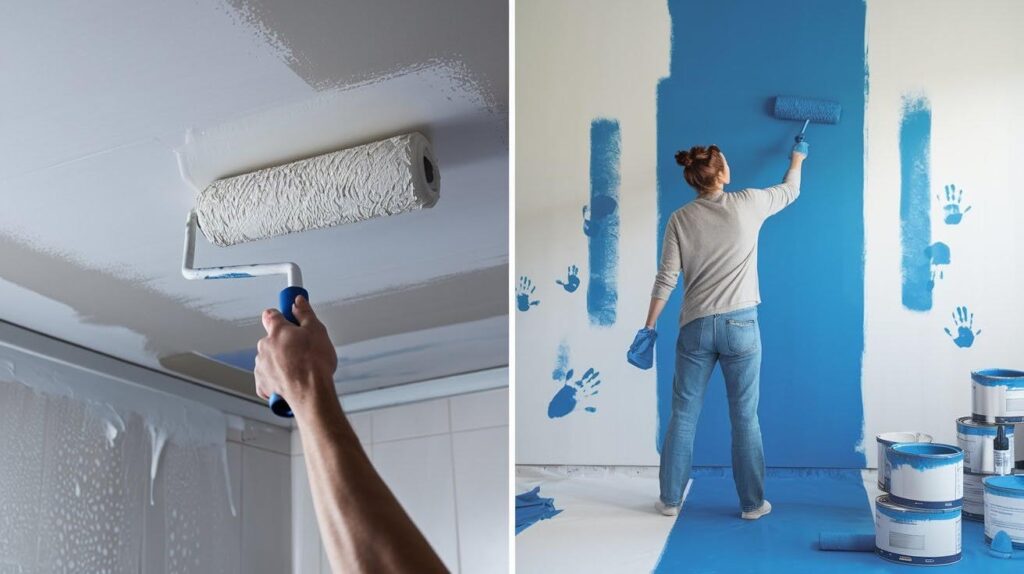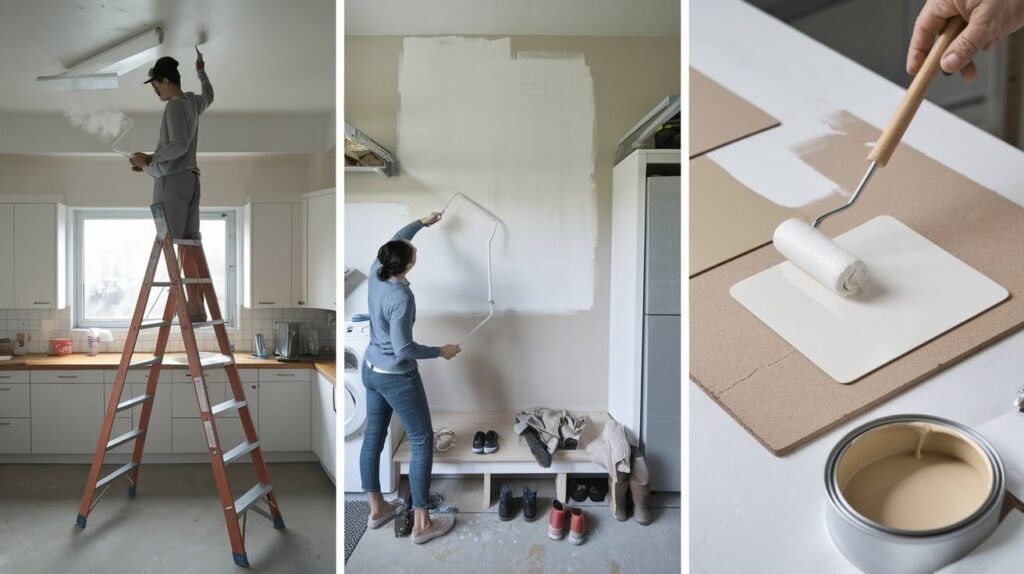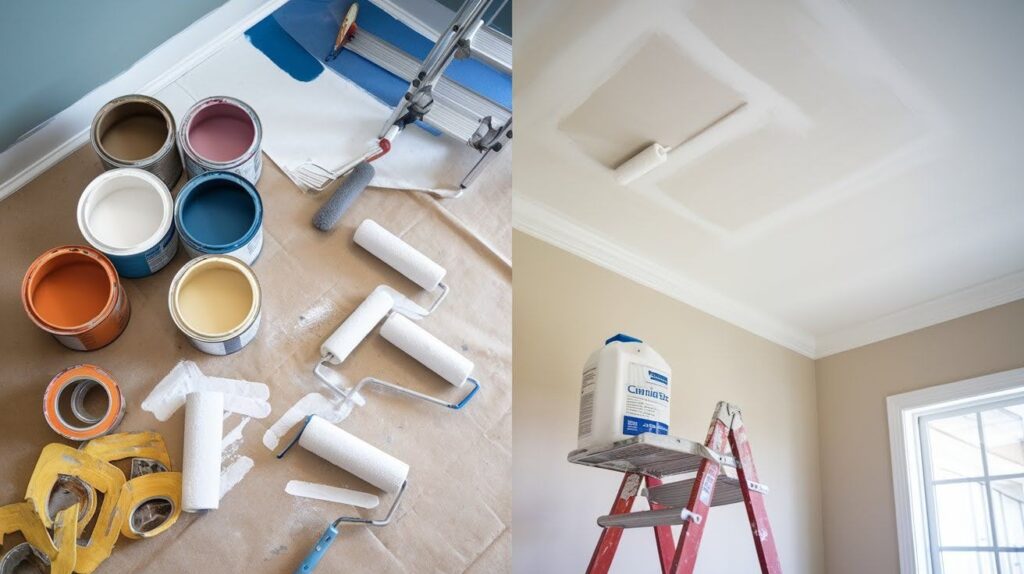After fifteen years of home renovation, I’ve seen countless homeowners make the same costly mistake, grabbing any interior paint off the shelf, assuming it works for every surface.
Last month, a client called me frustrated after her freshly painted ceiling showed roller marks and uneven coverage. She’d used regular wall paint thinking it would save money.
Here’s the truth: not all interior paints are created equal. Ceiling paint and wall paint serve different purposes, with unique formulations designed for specific challenges.
In this post, I’ll break down the real differences between these two paint types and help you choose the right one for your project, saving you time, money, and future headaches.
Understanding the Basics

What Is Ceiling Paint?
Think of ceiling paint as the heavyweight champion of interior paints. It’s formulated with a thicker consistency that won’t drip down your arm while you’re painting overhead. Trust me, I learned this the hard way during my first DIY project years ago.
This paint typically comes in a flat or matte finish, which helps hide those inevitable imperfections that show up on textured ceilings.
The best part? Modern ceiling paints dry quickly and resist stains and mildew, making them perfect for areas like bathrooms and kitchens where moisture is a concern.
What Is Wall Paint?
Wall paint is the versatile performer of the paint world. With its thinner consistency, it flows smoothly onto vertical surfaces and gives you plenty of finish options-from subtle eggshell to durable semi-gloss.
I always recommend satin or semi-gloss finishes for high-traffic areas like hallways and kids’ rooms because they’re much easier to wipe clean when life happens.
The variety in colors and finishes means you can truly customize each room to match your style and functional needs.
Key Differences Between Ceiling Paint and Wall Paint

1. Thickness & Application
Here’s where the rubber meets the road-or should I say, where the brush meets the ceiling. Ceiling paint has a thick, almost creamy texture that stays put when you’re working above your head.
I can’t tell you how many times I’ve watched homeowners try using regular wall paint on ceilings, only to end up with paint in their hair and all over the drop cloths.
Wall paint’s thinner formula works great on vertical surfaces where gravity helps it flow smoothly, but turn that same paint upside down and you’re asking for trouble.
2. Coverage & Coats Needed
One of my favorite things about quality ceiling paint is its hiding power. Most of the time, you can get away with just one coat, even when covering those stubborn water stains or crayon marks from your toddler’s artistic phase.
Wall paint, while excellent for its intended purpose, often needs two coats to achieve that rich, even color and that’s doubly true if you try using it on ceilings.
3. Durability & Resistance
Ceiling paint is built like a fortress against everyday household enemies. It shrugs off cooking smoke, bathroom steam, and those mysterious ceiling stains that seem to appear out of nowhere.
Wall paint focuses more on beauty and washability rather than these specific resistances, though you can find specialty formulas that offer similar protection.
4. Finish & Appearance
The flat finish on ceiling paint isn’t just about looks-it’s strategic. Those slight texture variations and minor ceiling imperfections practically disappear under a matte finish.
Meanwhile, wall paint gives you options: want something you can scrub clean? Go semi-gloss. Prefer a subtle glow? Try eggshell. The choice is yours.
5. Color Options
Let’s be honest, ceiling paint doesn’t win any awards for color variety. You’ll mostly find whites and soft neutrals, which actually makes sense since most people prefer their ceilings to fade into the background.
Wall paint, on the other hand, opens up a world of possibilities with hundreds of colors and custom tinting options to match your vision perfectly.
When to Use Ceiling Paint

Ideal Use Cases
Ceiling paint works best on smooth drywall ceilings, especially in kitchens and bathrooms where moisture and cooking stains are constant threats. I always reach for it when painting high ceilings. Trust me, you don’t want regular paint dripping from twelve feet up onto your furniture.
Ceiling Paint on Walls?
You can use ceiling paint on walls, and I’ve done it successfully in basements, mudrooms, and garages where durability matters more than looks. It also works as a primer or when you want an ultra-flat finish.
Just don’t expect vibrant colors or easy cleanup. Ceiling paint is built for function, not fashion-it won’t give you the rich hues or washable surface that dedicated wall paints provide.
Can You Mix Ceiling and Wall Paint?
This question comes up more often than you’d think. You can mix them if both paints have matching sheen levels, but always test a small batch first-I’ve seen too many projects go wrong when paints don’t play nicely together.
Mixing might help you achieve a specific consistency, but it’s really a gamble. Different formulations can create adhesion problems or uneven drying. My advice? Use the right paint for the job-it’ll save you touch-up work later.
Cost Considerations

Here’s where things get interesting from a budget perspective. Ceiling paint typically costs more per gallon – sometimes 20-30% more than standard wall paint. But before you dismiss it as overpriced, consider the bigger picture.
That “cheaper” wall paint often requires two coats when used on ceilings, which means you’re buying more paint anyway.
Plus, there’s the time factor, I’ve spent entire weekends applying multiple coats of wall paint to ceilings when one coat of proper ceiling paint would have finished the job.
Don’t forget about the hidden costs: extra prep time for covering furniture from drips, additional brushes and rollers for multiple coats, and the frustration of uneven coverage. Sometimes spending a bit more upfront saves you money, time, and sanity in the long run.
Final Tips for a Great Paint Job
Prep Tips
- Clean all surfaces thoroughly and lay down quality drop cloths. Trust me, cleanup time later isn’t worth skipping this step
- Fill holes and sand rough spots before you even open the paint can
- Always prime ceilings with stains, crayon marks, or dramatic color changes
Application Tips
- Paint your ceiling first, then tackle the walls gravity works against you otherwise
- Use a W-pattern with your roller for even coverage and fewer visible lap marks
- Consider a sprayer for large rooms or heavily textured ceilings, it’ll cut your time in half
Conclusion
After years of painting everything from cozy bedrooms to commercial spaces, I’ve learned that success comes down to matching the right paint to the job. The formula is simple: use ceiling paint on ceilings and wall paint on walls.
These products exist for good reasons, they’re specifically engineered for their intended surfaces.
That said, rules aren’t always rigid. I’ve successfully used ceiling paint on basement walls and wall paint for specialty ceiling projects, but only after careful consideration of the trade-offs.
My best advice? Don’t overthink it. Start with the basics, invest in quality materials, and remember that proper preparation trumps expensive paint every time. Your future self will thank you when you’re admiring that flawless finish years from now.
Frequently Asked Questions
Can I use wall paint on my ceiling to save money?
You can, but it’s not recommended. Wall paint will drip more, require multiple coats, and won’t hide ceiling imperfections as well as proper ceiling paint.
Is ceiling paint only available in white?
Most ceiling paints come in white or light neutrals, but some brands offer tinted options. The flat finish helps any color blend seamlessly overhead.
Why does my ceiling look streaky after painting?
This usually happens when using wall paint on ceilings or applying paint too thinly. Ceiling paint’s thicker formula and better coverage prevent this issue.
Can I clean ceiling paint if it gets dirty?
Ceiling paint is harder to clean due to its flat finish. For areas that need regular cleaning, consider a washable ceiling paint or low-sheen wall paint instead.
How do I know if I need primer before painting my ceiling?
Use primer when covering stains, switching from dark to light colors, or painting over glossy surfaces. New drywall also requires primer for best results.

